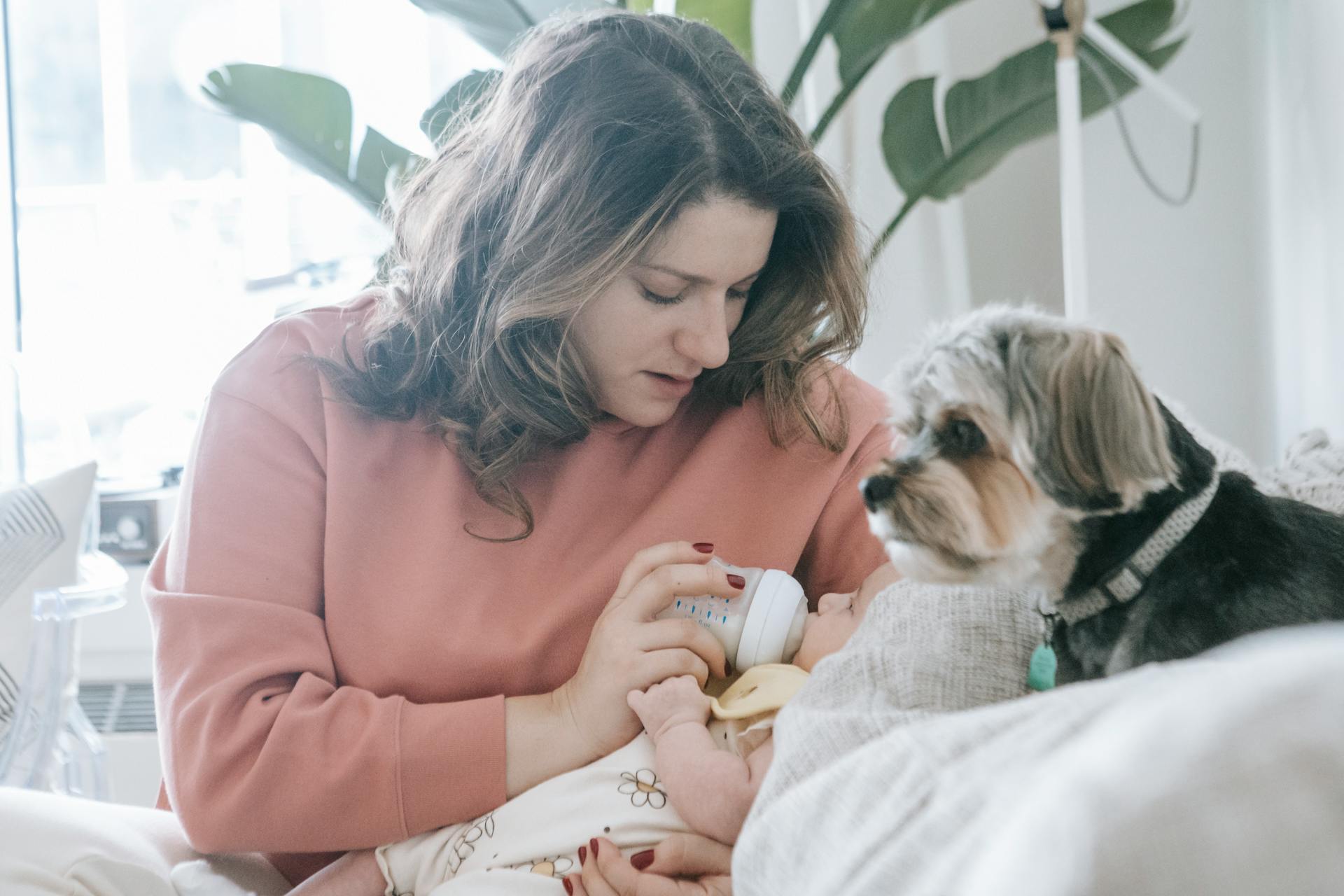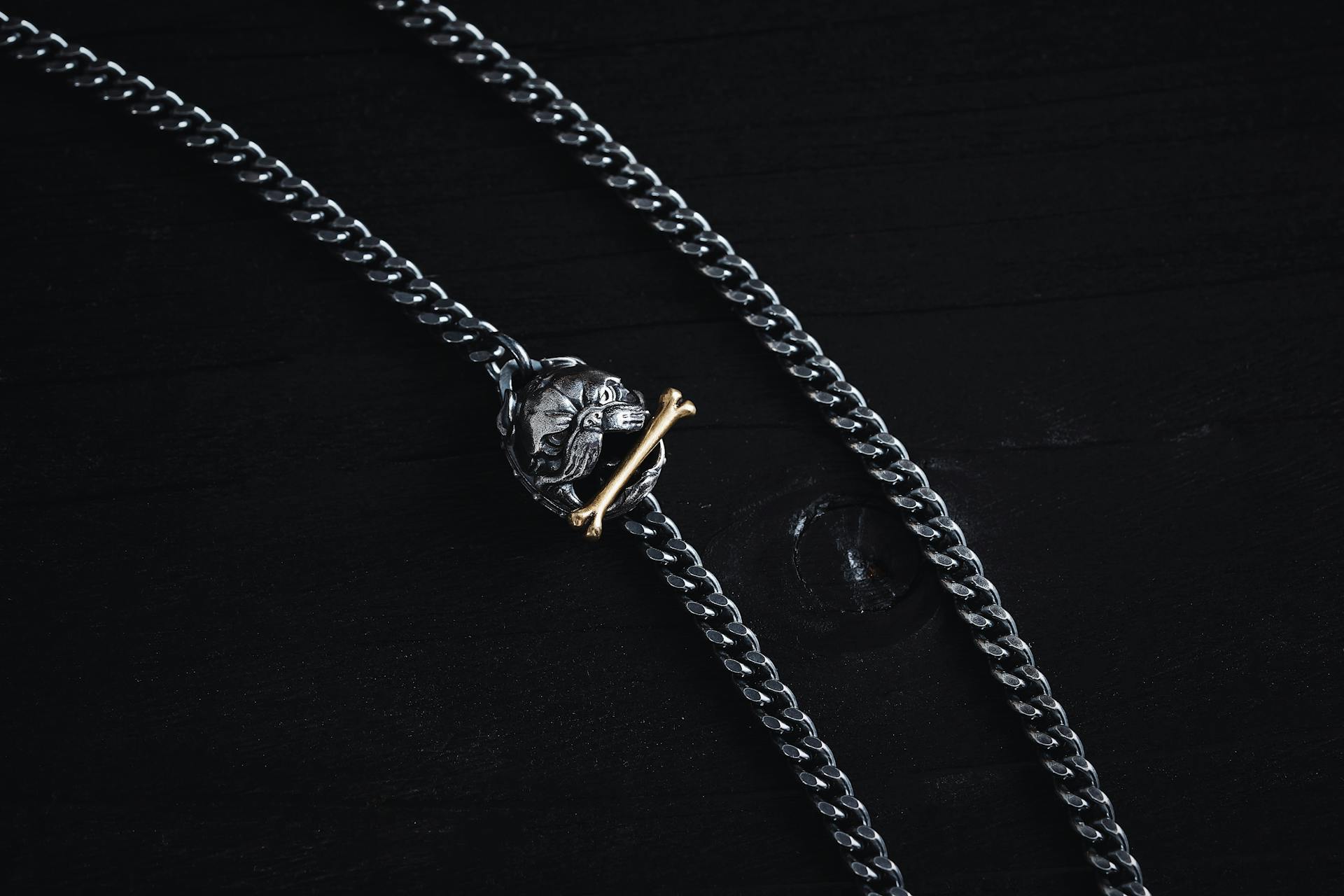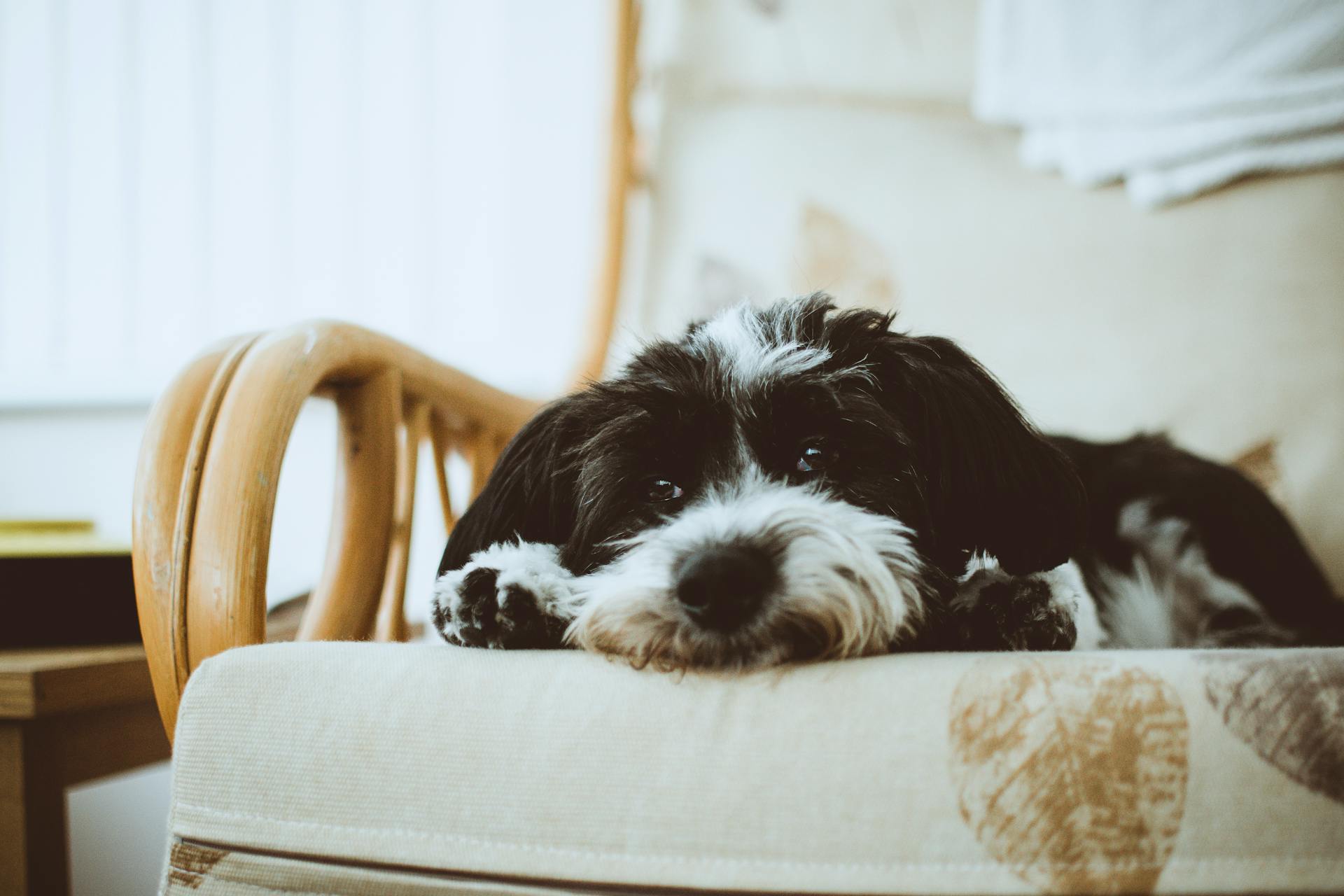
The Havanese mix breed is a delightful combination of the original Havanese dog with another breed, resulting in a unique and lovable companion.
These mixes often inherit the Havanese's gentle and affectionate nature, making them a great addition to families with children.
Havanese mixes can come in a variety of sizes, ranging from toy to standard, depending on the breed they're mixed with.
Some popular Havanese mix breeds include the Havanese Poodle, Havanese Chihuahua, and Havanese Yorkshire Terrier.
Recommended read: Malamute Mixes
Breed Options
The Havanese mix is a versatile dog breed that offers several options to suit different lifestyles and preferences.
The Havanese Bichon Frise mix, also known as the Bichon Havanese, is a popular combination that inherits the low-shedding coat of the Bichon Frise and the playful personality of the Havanese.
With proper training and socialization, the Havanese Poodle mix, also known as the Hapoodle, can thrive in a variety of living situations, from apartments to homes with yards.
Cavanese
The Cavanese is a sophisticated dog that loves to be waited on paw and foot, and they'll happily cuddle with you all day long. They sport a brown and white jacket, and their fluffy coat is a delight to behold.
This mix combines the Havanese with the Cavalier King Charles Spaniel, resulting in a dog that's both elegant and affectionate. They're perfect for families who want a low-maintenance pet that will shower them with love and attention.
The Cavanese is a relatively low-maintenance breed, requiring only moderate exercise and regular grooming to keep their coat looking its best. They're also relatively small in size, weighing between 7 and 13 pounds, making them a great option for apartment dwellers or those with limited space.
Their gentle nature and playful personality make them a great addition to any family, and their small size means they'll fit right in with your existing furniture.
Expand your knowledge: Are Havanese Dogs High Maintenance
7. Havamalt
The Havamalt is a popular mix that's hard to resist, weighing in at just 7 to 13 pounds. They're small but mighty, and their brilliant white coat with occasional brown splashes makes them a stunning companion.
These little dogs crave human company and will follow you everywhere, becoming your second shadow in no time.
10. Puganesse
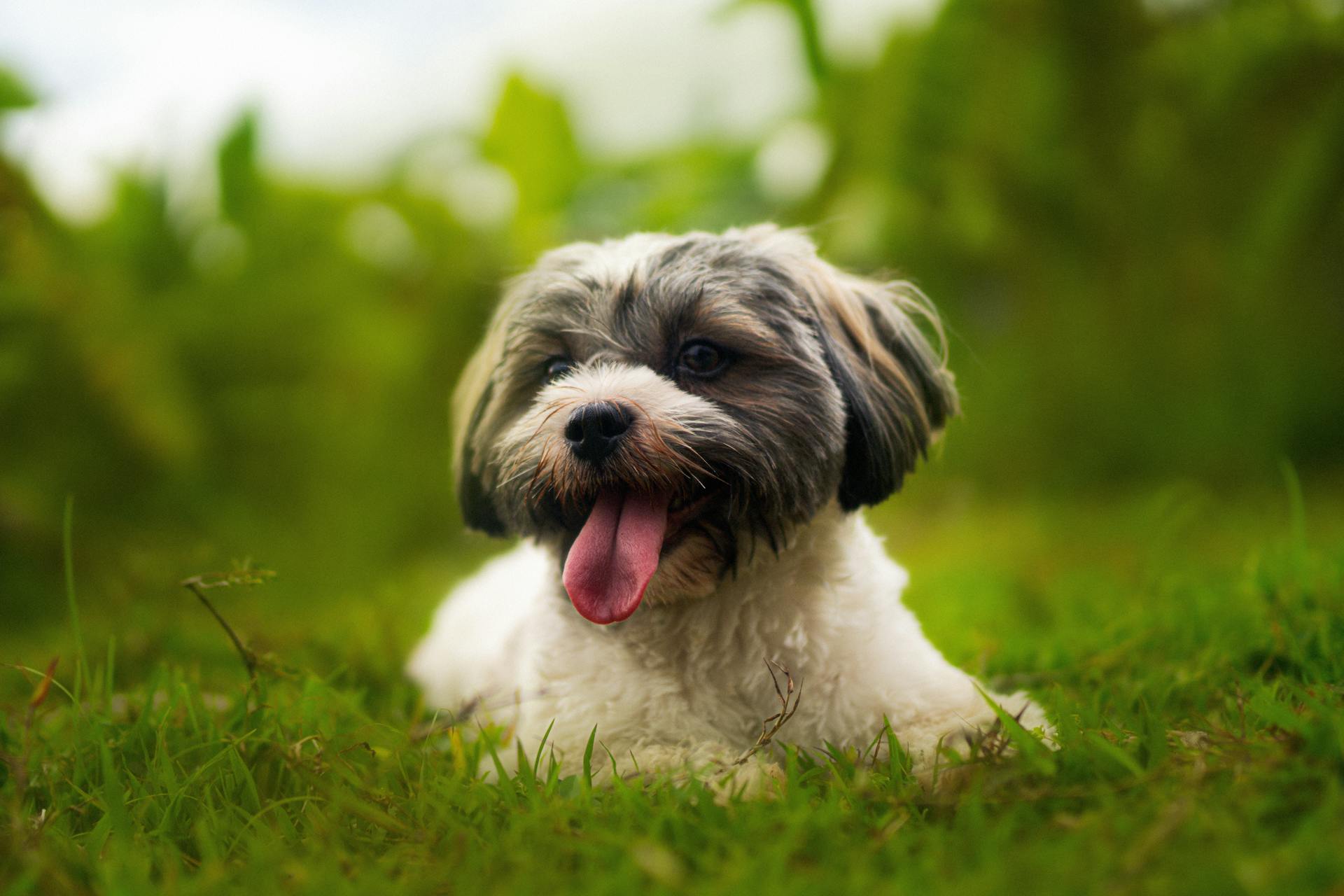
The Puganese is a brachycephalic breed mix that will snore throughout the night. They are known to be mischievous and full of character.
This breed mix has a shorter coat and skin folds, giving it a chubby-looking appearance. They are adorable companions.
If you can't see or hear them, they're probably up to no good, as they are prone to getting into trouble.
Specific Breeds
The Havanese mix is a versatile breed that can be a great addition to many families. They come in a variety of sizes, including toy, miniature, and standard.
One key thing to note about Havanese mixes is that they can inherit the small size of the Havanese parent, weighing around 7-13 pounds.
Havaton
The Havaton is another fluffy dog that will steal your heart with its comical personality. They love to spend their day goofing and romping around, making them a perfect match for an active family.
This exotic Madagascan mix is full of energy and needs to be placed with a family that can keep up with their playful nature.
Havashu
The Havashu is a lovable mix of Havanese and Shih Tzu, known for their gentle nature and affectionate personalities, making them an excellent canine sibling for children.
They can live up to 18 years of age, which is a long time to enjoy their company. Their coat is usually a combination of tan, black, grey, brown, and gold with long and silky hair.
These pups are very energetic and do well with children, as long as you give them attention, that is! They're pretty content most of the time, but they'll still keep you on your toes.
They're relatively small, only about 8 to 12 inches tall and 8 to 15 pounds, so they're a great fit for apartment living. Exercise them a lot, or they'll be wearing you out!
Broaden your view: Havanese Long Hair
Havashire
The Havashire is a spunky pooch who is full of Terrier tenacity. They love to play games with family, and will not give up until they win!
This feisty little pooch has a lot of personality and attitude, but this is why everyone loves them. It is a loving family addition who wants plenty of cuddles.
They can be a bit challenging to train, requiring patience and a long-term commitment. It's not the best breed for first-time owners.
Their coat is a mixture of black, cream, brown, golden, and other similar colors. One of the things that makes them so adorable is their long shaggy coat, but it can become a hassle if you're not willing to brush it every day.
Daily brushing is a must to prevent matting and tangling. They can live in an apartment and be mostly content as long as you give them daily walks.
Characteristics
The Havanese mix is a lovable and adaptable breed, with a lifespan of 10-15 years. They make great companions for many families.
Their size is small, which makes them perfect for city living or apartments. They require moderate exercise to stay happy and healthy.
Havapoos are known for their friendly and gentle nature, which makes them a great candidate for therapy or service dog work. They're also highly intelligent and playful, always up for a good time.
One thing to keep in mind is that they can be prone to separation anxiety, so it's essential to provide them with plenty of attention and interaction. They're sensitive dogs, so patience and positive reinforcement are key when training them.
Here are some common coat types and colors you might see in a Havanese mix:
- Curly, wavy, or silky coat types
- White, black, brown, fawn, cream, tan, apricot, and combinations of these colors
Despite their generally healthy nature, Havapoos can be prone to hip dysplasia, patellar luxation, and eye problems. Regular check-ups with your vet can help catch any potential issues early on.
Health and Care
Havaneses are generally healthy dogs, but like all breeds, they can inherit health issues from their parents. Regular grooming and veterinary check-ups can help prevent or catch these issues early.
It's essential to keep your Havapoo's nails trimmed, as they can grow too long and cause discomfort. Brush their teeth a few times a week to promote good dental health and prevent issues like early tooth loss.
Havapoos have medium energy levels and need regular exercise to stay happy and healthy. A daily walk or playtime in the backyard can help them get the physical and mental stimulation they need.
Worth a look: Havanese Skin Issues
Return
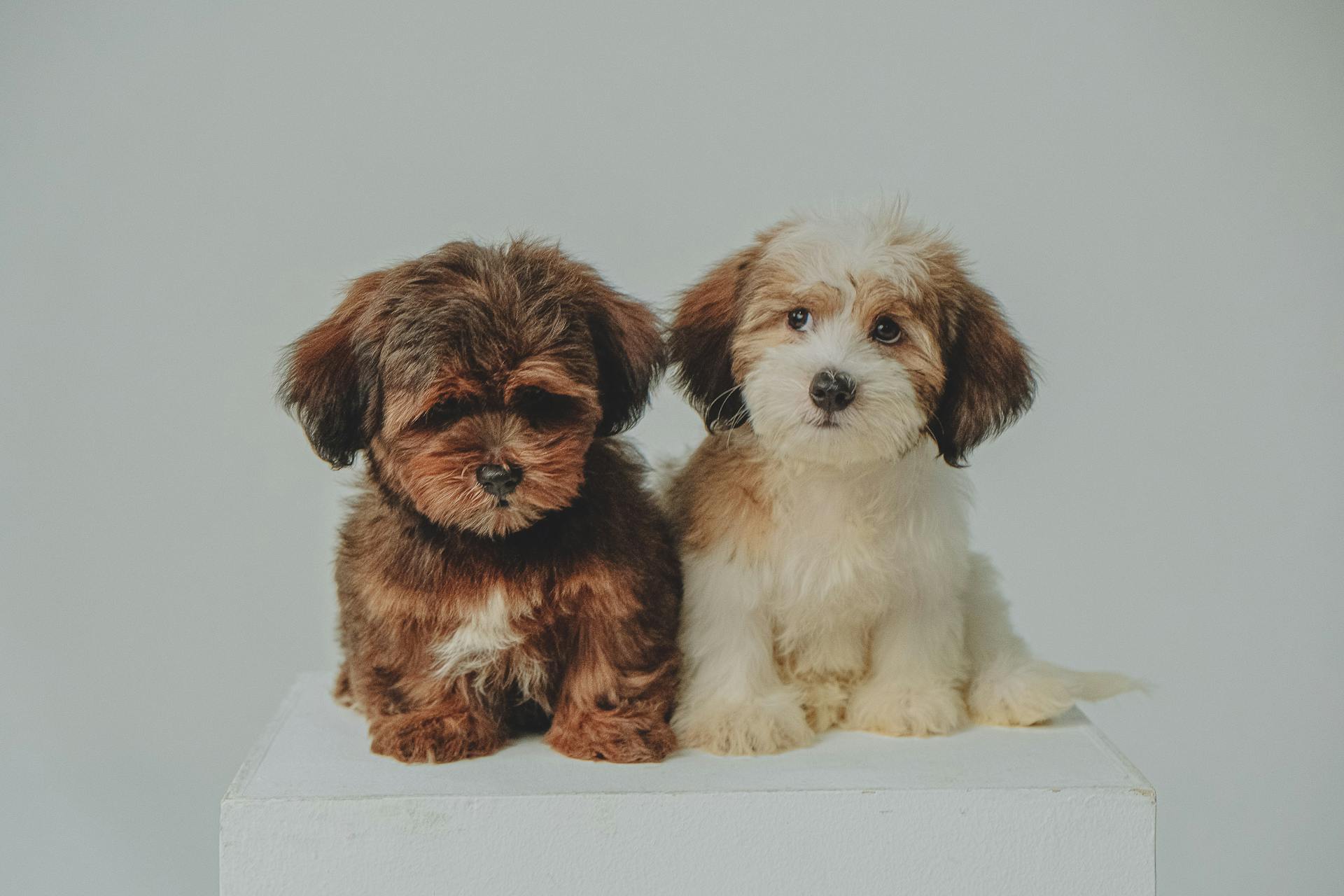
The Havachon is a low-maintenance dog when it comes to exercise, requiring only short daily walks.
Their small size means they can thrive in apartments or small homes.
With a weight range of 7 to 18 pounds, they are perfect for city living.
Their cute button eyes and fluffy coat make them a joy to look at.
They are intelligent and can learn circus tricks in no time, making them a great companion for active owners.
Regular grooming is essential to prevent matting and tangling of their beautiful coat.
Health
Havapoos are generally healthy dogs, but like any breed, they can inherit health issues from their parent breeds. They may be prone to hip dysplasia, a developmental malformation of the hip joint that can lead to wear and tear, pain, and arthritis.
Hip dysplasia and patellar luxation are common issues in Havapoos, which can cause lameness and pain. Regular exercise and a healthy diet can help prevent or manage these conditions.

Eye issues, including cataracts and progressive retinal atrophy, can also affect Havapoos. Deafness, thyroid issues, and Addison's disease are other potential health concerns. Epilepsy is a neurological disorder that can cause recurring seizures.
Here are some common health issues that can affect Havapoos:
- Hip Dysplasia
- Patellar Luxation
- Eye Issues (cataracts, progressive retinal atrophy, etc.)
- Deafness
- Thyroid Issues
- Addison's Disease
- Epilepsy
Regular veterinary check-ups and health testing can help identify potential health issues early on. Your veterinarian can provide personalized recommendations for your Havapoo's specific needs.
Consider reading: Havanese Breed Problems
Health and Care
Havapoos are moderately prone to weight gain, so it's essential to feed them measured amounts of food and limit treats.
To prevent bloat, a common health issue in Poodle breeds, it's a good idea to keep exercise at least an hour apart from feeding, both before and after.
As Havapoos grow from puppyhood to adulthood and into their senior years, their dietary needs will change, so it's crucial to consult with your veterinarian for recommendations on their diet.
Havapoos can inherit health issues from their purebred parent dog breeds, including hip or elbow dysplasia and eye issues like Progressive Retinal Atrophy.
You might like: Ridgeback Mix Dogs

Adult Havapoos need food with probiotics for improved digestion and better immunity, while senior Havapoos can benefit from dog food enriched with chondroitin and glucosamine for enhanced joint health.
Good dog food should provide Havapoos with protein, fibre, vitamins, and minerals, as well as vegetables and fruits that are GMO-free to give them all the antioxidants they need.
On a similar theme: Havanese Food
Dog Allergies: Causes, Symptoms & Treatment
Dog allergies are a common struggle for many dogs and poodle mix breeds are no exception.
Food or environmental allergies can cause a dog itchy rash on the belly area.
Parasites are another possible cause of dog itchy rash on the belly.
Symptoms of dog allergies can include itchy skin, scratching, and chewing at the affected area.
Treatment for dog allergies often involves identifying and avoiding the allergen, as well as using medication to alleviate symptoms.
Preventing dog allergies can be achieved by considering a dog's genetic predisposition to allergies before bringing them home.
Additional reading: Havanese Dogs and Allergies
What Is the Difference Between Poop?
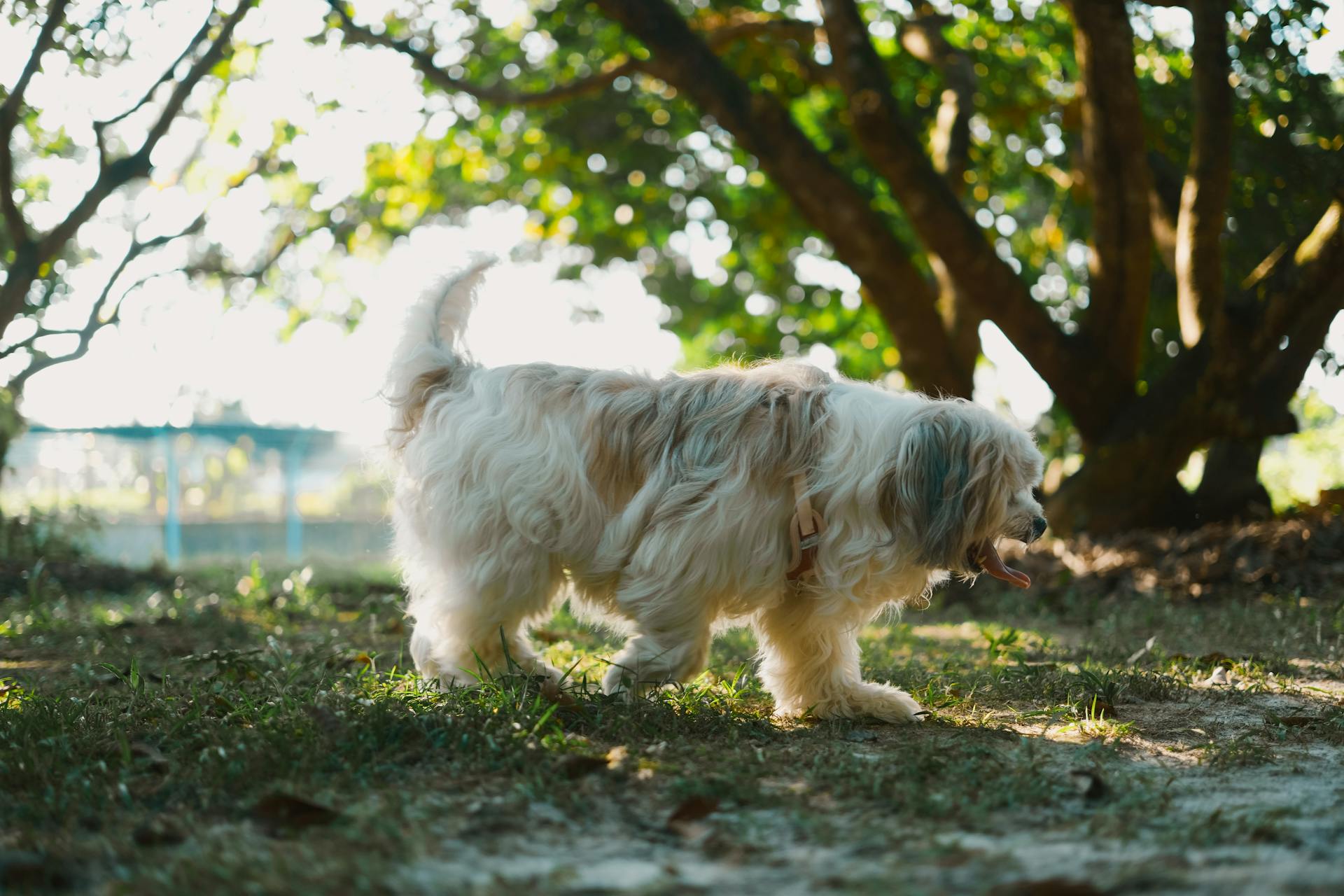
The Havanese and Havapoo have distinct coat textures - the Havanese has a straighter coat, while the Havapoo's coat is more prone to knots and mats.
If you have a Havapoo, you'll need to brush its coat at least 2-3 times per week to prevent matting and knots.
The Havapoo's tendency to tangle makes it less likely to shed, making it a good option for those looking for a hypoallergenic dog.
On the other hand, the Havanese sheds more, but its coat is easier to maintain between groomer visits.
Regular brushing is a must for poodle crossbreeds like the Havapoo to keep their coat healthy and prevent matting.
A unique perspective: Havapoo vs Havanese
Size and Grooming
Havapoos are small dogs, typically standing between 8 to 15 inches tall and weighing between 7 and 30 pounds.
Their size can vary depending on the size of the Poodle parent used in the cross, but miniature or toy Poodles are often used, resulting in a small dog.
To keep their coat looking its best, Havapoos need to be brushed a few times a week and bathed every one to two months, depending on their activity level.
Their coat can be dense and curly, like their Poodle parent, or long and silky, like their Havanese parent, and may require regular trimming by a professional groomer.
You'll also need to brush their teeth daily to prevent problems, and inspect their ears and claws from time to time to catch any potential issues early on.
Coat Color and Grooming
Havapoos come in many colors and combinations, including black, white, brown, tan, grey, silver, apricot, and "blue." Their coat can be dense and curly, like their Poodle parent, or long and silky, like their Havanese parent.
Brushing is essential to prevent mats and remove dirt and parasites, so brush your Havapoo at least 2-3 times a week. Brushing regularly will also help prevent the development of natural felted cords if your Havapoo inherits the Havanese coat.
Take a look at this: Havapoo vs Maltipoo
Frequent brushing is needed to keep the Havanese-type coat long and silky, and your Havapoo should be bathed every one to two months. If you don't brush your Havapoo regularly, their coat will develop mats and tangles.
Your Havapoo's coat grows rapidly, so you'll need to trim it frequently to keep it manageable. You can trim your dog's nails once a month, and bathing is recommended as a once-a-month activity, but more frequent bathing may be needed if your pet swims or rolls around in the dirt often.
If your Havapoo inherits the Poodle-style fur, it will naturally repel water, but they'll still need wiping down after getting caught in the rain. Providing shelter and water in extreme weather is crucial, especially for Havanese-influenced coats that have a medium tolerance to both hot and cold temperatures.
For more insights, see: Cavapoo vs Havapoo
Physical Size
The Havapoo's size can vary quite a bit, typically ranging from 8 to 15 inches in height and weighing between 7 and 30 pounds.
Havapoos are generally small dogs, but they can be bigger than their Havanese parent.
Their size is not standard and depends on their Poodle genes, with some breeders using Miniature Poodles and others using Toy Poodles.
You can expect your Havapoo puppy to grow up to 8-15 inches tall at the shoulders and weigh between 10-45 pounds.
Some Havapoos may be even smaller, weighing less than 3kg, especially if they're a teacup-size poodle mix.
The resulting Havapoo pup can have a wide range of coat colors, including black, tan, white, cream, brown, chocolate, merle, and golden.
The Havanese parent's long, silky coat is a common trait in Havapoos, which can be seen in a variety of colors and patterns.
Explore further: Havanese Dog Colors
Temperament and Training
Havapoo owners will notice their dog's sharp intelligence, making them easy to train and quick to learn commands.
They thrive on attention and affection, so be prepared to spend quality time with your Havapoo.
Their high energy levels require daily walks to expend energy and burn calories, which also lets them sniff around.
You can also invest in puzzle toys that make them work for their food, keeping them mentally stimulated.
Havapoos are great lapdogs and are happiest with their families, but they do need mental stimulation to prevent boredom.
Early training and socialization are key to bringing out their best qualities, and they tend to get along well with other dogs and kids if socialized from a young age.
Crate training can help with separation anxiety, a common issue in Havapoos, and responsible breeders should start this process from an early age.
These intelligent dogs can be trained with reward-based methods, building trust and a special bond.
However, they can be stubborn at times, so patience and consistency are essential when training a Havapoo.
They love to run and play, making them suitable for agility, flyball, and obedience training.
Havapoos are generally calm and gentle, making them great companions for all ages, but they will still bark to alert you of strangers or to make exclamations while playing.
A fresh viewpoint: Havanese Training
Breed-Specific Information
The Havanese mix is a cross between a Havanese and another breed, which can result in a unique combination of characteristics.
Their small size, typically weighing between 7-13 pounds, makes them a great fit for city living or families with small children.
Their hypoallergenic coat requires regular grooming to prevent matting and tangling.
They are known for their friendly, outgoing personalities, which make them excellent family pets.
28. Golden
The Golden Havanese is a big dog, weighing in as the heaviest and largest on this list. It's a mix of a Havanese and a Golden Retriever, giving it a bigger build than a standard Havanese but with a beautiful golden coat.
This breed is known for being friendly and loving, making it a great fit for families with children. They're always up for a game, so be prepared for some energetic playtime.
The Golden Havanese is a great choice for most families, especially those with kids, due to its friendly and outgoing personality.
Havanese mix
Havanese mixes, like the Havapoo, can have a variety of coat colors and types. They can be solid, two-toned, or three-toned, with colors including black, white, brown, tan, grey, silver, apricot, and "blue".
Their coats can be dense and curly, like their Poodle parent, or long and silky, like their Havanese parent. This means they'll need regular grooming to prevent matting and tangling.
Havapoos can inherit the Havanese coat, which can be styled naturally in two ways: long and silky, or with natural felted cords if not brushed regularly. Brushing a few times a week and bathing every one to two months will keep their coat looking its best.
As Havanese mixes, they have a medium tolerance to both hot and cold temperatures, so be sure to provide shelter and water in extreme weather. This is especially important for older dogs, who may need extra protection from the cold.
Their Poodle-style fur naturally repels water, making them a great choice for families who love the outdoors. However, they'll still need wiping down after a rain shower to prevent dirt and debris from building up.
Curious to learn more? Check out: Silky Terrier Dachshund Mix
Havapoos are also hypoallergenic, thanks to their Poodle and Havanese heritage. This makes them a great choice for allergy sufferers, but it's essential to remember that no dog is 100% hypoallergenic.
Regular grooming is a must for Havanese mixes, especially those with the Havanese coat. Brushing a few times a week and bathing every one to two months will keep their coat looking healthy and shiny.
You might like: Hypoallergenic Husky Poodle Mix
Bichon Frise Origins
The Bichon Frise Origins are quite fascinating. They originated from the Spanish island of Tenerife, where they were a companion dog to sailors.
Their original name was the Bichon Tenerife, and they spread across Europe, becoming a favorite among royal courtiers in Spain, France, and Italy.
It's no surprise they were pampered, given their adorable white coats and charming nature. Their popularity didn't last, however, and during the French Revolution, they were left out on the streets.
Many Bichon Frises adapted to their new circumstances by becoming performing circus dogs, showcasing their infectious and entertaining personalities.
After the two world wars, a group of European fanciers took the Bichon Frise under their wing, and soon they were back in vogue.
Finding and Cost
Finding a reputable breeder can be challenging, especially for a rare mix like the Havanese Bichon. Havapoos, a similar mix, can cost between $2000 to $4000 from a reputable breeder.
The price of a Havapoo depends on several factors, including lineage, coat color, age, and the breeder's reputation. Be prepared to spend between $15,000 and $20,000 over the pet's lifetime, including initial costs and ongoing care.
Havachon breeders can be hard to find, so be prepared to wait for a puppy. Meeting the mother of a prospective Havachon puppy and ensuring the breeder provides health checks for both parents are crucial steps in finding a responsible breeder.
You might like: Doberman Lab Mix Dog
Finding Puppies
Finding puppies of a Havanese Bichon Mix can be a challenge due to their relative rarity.
You may have to wait for a puppy of your own, but it will be worth it given their adorable nature.
Breeder recommendations are the best way to go, and the internet is a good resource to find them.
Finding a reputable breeder is crucial to avoid puppy mills, which are very real.
Always meet the mother of a prospective puppy, and ensure the breeder provides paperwork showing both parents' health checks.
If a breeder is unwilling to provide this or you're unhappy with anything, be strong and walk away.
Considering a Havachon rescue is also a great option to give a home to a dog in need.
For your interest: Cute Puppy Havanese
Cost Estimate
When considering the cost of a Havapoo, it's essential to factor in the initial purchase price from a reputable breeder. Havapoos from reputable breeders can cost between $2000 to $4000.
The price of a Havapoo puppy depends on several factors, including its lineage, coat color, age, and the breeder's reputation. Finding a good breeder can be challenging due to the rarity of Havapoos in the USA and Australia.
You'll also need to consider the lifelong care of your pet, which can be expensive. Most small dog owners spend between $15,000 and $20,000 over their pet's lifetime.
Suggestion: Corgi Husky Mix Cost
Frequently Asked Questions
How big does a Havapoo get?
A Havapoo typically grows up to 18 inches tall and weighs 7-30 pounds, with size varying depending on the poodle type used in breeding.
What is the temperament of a Havanese Shih Tzu mix?
The Havashu is a playful, affectionate, and intelligent dog that thrives on social interaction and family bonding. With proper socialization, they make great companions for kids and other pets.
What is the lifespan of a Havanese terrier mix?
The average lifespan of a Havanese terrier mix is 14 to 16 years, with some living even longer. With proper care, your Havanese companion can thrive for a long and happy life.
What breeds make up the Havanese?
The Havanese is descended from the ancient Bichon family of small white dogs, with probable common ancestors including the Bichon Frise and Maltese. These breeds share a common heritage with the Havanese.
What are Havanese descended from?
The Havanese breed originated from Tenerife dogs brought to Cuba by Spanish farmers and noblemen in the 1500s. These dogs developed into the Havanese breed with minimal outside influences.
Featured Images: pexels.com
